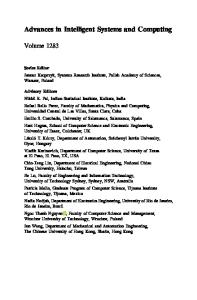Design and development of an immersive virtual reality news application: a case study of the SARS event
- PDF / 2,533,456 Bytes
- 24 Pages / 439.37 x 666.142 pts Page_size
- 38 Downloads / 304 Views
Design and development of an immersive virtual reality news application: a case study of the SARS event Huiyue Wu 1,2
1
1
1
& Tong Cai & Yingxin Liu & Dan Luo & Zhian Zhang
1,2
Received: 12 February 2020 / Revised: 13 August 2020 / Accepted: 9 September 2020 # Springer Science+Business Media, LLC, part of Springer Nature 2020
Abstract
In recent years, virtual reality (VR) technologies have been applied to the field of journalism, where the concept of immersive VR news has been proposed. However, despite the fanfare, strong response, and sensational effect caused by its advent, immersive VR news remains a novel journalism paradigm that faces new challenges in its production process. Currently, there is a lack of a unified design framework, and, since most studies in this area have focused on noninteractive VR news, the understanding of the effects of more interactive VR technologies on the news consumer remains inadequate. In this study, we propose a more practical design framework for immersive VR news products. Following this framework, we designed a VR news application and conducted user evaluation in terms of media effects and user experience. Based on the experimental findings, which demonstrated that non-interactive VR news products resulted in a distracting user experience and less immersion, while interactive VR news offered improved media effects and user experience, we then derived concrete design guidelines for immersive VR news design. Finally, we highlight that this study provides a theoretical and practical reference framework for the further study of VR news. Keywords Immersive journalism . Virtual reality . User experience . Media effects
1 Introduction Immersive journalism refers to news that aims to establish a connection between the audience and the news story by offering first-person experiences of events or situations [35]. Generally, the sense and illusion of embodiment is created through spatial perception as digital avatars, which is the basis of immersive journalism [35, 41, 43]. “Immersion” in * Huiyue Wu [email protected]
1
The School of Communication and Design, Sun Yat-sen University, Guangzhou, China
2
Guangdong Key Laboratory for Big Data Analysis and Simulation of Public Opinion, Guangzhou, China
Multimedia Tools and Applications
journalism has evolved from the narrative strategies used by journalists to arouse audiences’ empathy in the early practice into a multi-channel experience utilizing the technology changes of recent years [8, 10, 42]. Currently, immersive journalism is mainly presented in two forms [25, 28, 32]. One is 360° video, which can immerse audiences in real news scenes captured by photographic equipment. Since this new product form is easy to develop, it has been widely used in the media industry; however, the lack of interaction and embodiment results in lower user engagement in traditional 360° video news. The other is known as VR news, which generates a digital experience that closely simulates the real world using virtual reality technolog
Data Loading...











